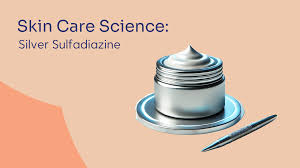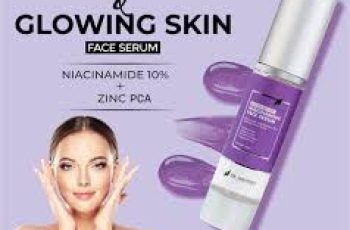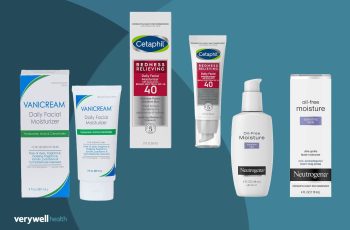The Science of Silver Sulfadiazine in Wound & Burn Care
Also referred to as sulfadiazine, this ingredient is used in many wound creams and is especially useful for treating burns. While sulfadiazine is not used for cosmetic purposes, it can be good to have on hand in case of skin injuries or burns in the kitchen. There are, however, some more recent studies with specific guidelines on how and when to use sulfadiazine for skin injuries. I’ll walk you through the benefits, drawbacks, and latest guidelines on silver sulfadiazine here.
Silver sulfadiazine is a topical antibacterial ingredient used to treat skin injuries and burns.
It also has anti-inflammatory properties.
It should not be used for long-term wound care.
What Is Silver Sulfadiazine?
Silver sulfadiazine contains both silver and sulfadiazine, two ingredients known for their antibacterial and antimicrobial properties. On its own, sulfadiazine is a synthetic antibiotic designed to fight bacteria by inhibiting their ability to grow and spread. Silver sulfadiazine is commonly used in medical settings to prevent infections, particularly in burn wounds, where infection prevention is crucial for safe and efficient healing.
How Does Sulfadiazine Work?
Sulfadiazine is in the class of sulfa drugs, which all contain the same molecular structure and work in a unique way that does not kill bacteria but inhibits its growth. This class of antibiotics inhibits an enzyme called dihydropteroate synthase (DHPS), which is responsible for the production of folic acid within the bacteria (3). Without this essential nutrient, bacteria are unable to grow and thrive.
Silver ions in silver sulfadiazine disrupt bacterial cell walls, which further prevents bacteria from multiplying and spreading. These qualities make silver sulfadiazine particularly effective against a wide range of bacteria, including some resistant strains.
Benefits of Sulfadiazine
Sulfadiazine is used both as a prescription and over-the-counter treatment for minor to moderate wounds and burns. Its antibacterial properties help to prevent infections against a broad range of bacteria strains, including some resistant strains. Additionally, silver is known to have anti-inflammatory benefits, which can help to reduce redness and discomfort in the initial stages of healing (4).
Side Effects of Silver Sulfadiazine
For short-term wound or burn treatment, silver sulfadiazine comes with few side effects. However, there are a couple of rare complications to note about this ingredient:
Allergies. Some people have allergies to sulfa drugs, which can cause reactions ranging from mild skin rashes to severe symptoms like swelling, fever, and difficulty breathing. Anyone with a sulfa allergy should avoid using silver sulfadiazine.
Argyria. This is a rare phenomenon where the skin turns a bluish-gray color as a result of silver exposure. Direct sunlight after using topical silver sulfadiazine may increase the risk of developing this rate condition (5).
May slow wound healing when used long-term. Some studies suggest that silver sulfadiazine may actually slow wound healing if used for longer periods of time (6-8).
How to Use Silver Sulfadiazine
As mentioned above, some studies have found that silver sulfadiazine may be most effective when applied during the initial stages of wound healing, but has the potential to then slow healing if used for prolonged periods of time (6, 7). This is because prolonged use of sulfadiazine may begin to damage fibroblast cells, which are crucial for wound healing (7, 8). As a result, alternative silver-based dressings and other antimicrobial ingredients are being studied for better long-term wound management.
Thus, if treating a wound or burn with over-the-counter sulfadiazine, use caution when using for a long period of time. Seek medical care if you have a minor wound or burn that is not responding to at-home treatment or if you have a more significant wound or burn.
Products That Contain Silver Sulfadiazine
Silver sulfadiazine is found in both prescription creams and some over-the-counter medical-grade products like Elta MD SilverGel . This product is well-known for its antibacterial properties and is commonly used as a post-procedure skin cream to aid in wound healing. It can also be used for minor cuts and burns that aren’t serious enough to require medical attention.
Other Post-Procedure Skin Care
If you are not dealing with a moderate wound or burn but are looking for a milder product that can still aid in wound or skin healing and repair, consider the options below.
Bottom Line
Silver sulfadiazine can be a helpful addition to your first-aid kit for treating minor burns or wounds and helping to prevent infections. However, avoid using this ingredient long-term to avoid slowing the healing process in its later stages. Always consult with your doctor for severe burns or deep wounds to ensure proper treatment.
For customized advice about other skin care products in your regimen, don’t forget to take the Skin Type Quiz to find out your Baumann Skin Type!
DQH Knowledge drop: In your 20s, your skin cell turnover decreases. (Cell turnover is a key component in keeping your skin youthful.) You know what else slows down? Your collagen production. Starting in your 20s, collagen decreases by about 1 percent per year. Should you want to prevent fine lines and wrinkles, start by eliminating behaviors that contribute to premature aging. “If it’s bad for you, it’s bad for your skin,” says dermatologist Michel Somenek.
“Cigarette smoking reduces blood flow to the skin and causes premature wrinkling and a dull skin texture. Making the repeated pursed motion to inhale can also cause smoker’s lines. Alcohol and recreational drugs are toxins for the skin that damage its cellular structure and DNA,” Somenek tells us. “The faster you eliminate vices while you are young, the better chance your skin and body have to recuperate.” Also, adopting an anti-aging routine in your 20s is key. After all, the best offense is a good defense. We spoke to Somenek and experts Joshua Ross and Audrey Kunin to find out more.
Keep reading for the best anti-aging products for your 20s, according to skincare professionals.
Sunscreen
“We all know that the sun is the number one cause of skin aging and starting the prevention in your 20s is very important,” Ross says. “The majority of your sun damage won’t start to appear until you’re in your 30s, so don’t wait until you see it surface or you’ll be behind the curve. Stay ahead of it with a good-quality zinc-based sunscreen worn daily.”
Farmacy Green Defense Daily Mineral Sunscreen
An invisible sunscreen with SPF 30, plus botanical extracts meant to protect skin with tons of antioxidants. Bonus: It’s clean and fine to use under makeup.
Bareminerals Complexion Rescue™ Tinted Moisturizer Broad Spectrum SPF 30
Although we recommend you use your SPF and moisturizer separately, we also understand moments when you don’t have time or energy for that extra step. For those times, this bareMinerals moisturizer is a great thing to have on hand.
Vitamin C Serum
“A great introduction to anti-aging is to start with a vitamin C serum in your morning skincare routine,” Ross says. “It’s a powerful antioxidant that will neutralize free radicals and brighten the skin.” He adds that it’s a great way to counteract the effects of the sun’s harmful rays, which, as previously mentioned, are among the biggest causes of premature aging.
Drunk Elephant C-Firma™ Vitamin C Day Serum
The Drunk Elephant C-Firma is a lightweight serum that promises to give skin a glow by combining the brightening powers of vitamin C with ferulic acid, l-ascorbic acid, and vitamin E. The included sodium hyaluronate is meant to replace hydration loss, so you shouldn’t have to deal with any irritation.
Sunday Riley C.E.O. Rapid Flash Brightening Serum
This potent serum is jam-packed with vitamin C (15 percent, to be exact), which means it’s a potential superstar at both brightening skin and dousing it in antioxidants.
Peptides
Using peptides on your skin has many benefits, says Somenek. “The skin barrier is what defends the body against pollution, UV rays, bacteria, and toxins. It can be damaged by several everyday factors. Using topical peptides aids in building a stronger barrier,” he says. “Peptides comprise elastic fibers, which are a type of protein. These fibers help to make skin appear taut and firm. Peptides can also help repair damaged skin, relieve inflammation, and even out skin tone. Some peptides can kill acne-causing bacteria that is common in 20-somethings.”
Kunin agrees, saying, “Peptides are an excellent entry point for supporting collagen.” She recommends looking for face and eye treatments that contain these collagen-boosting powerhouses.
Charlotte Tilbury Magic Eye Rescue Cream
This Charlotte Tilbury super-emollient eye cream has a base of coconut oil and shea butter (read: it’s incredibly hydrating). Botanicals plus peptides are meant to help reduce dark circles and boost collagen, respectively.
This creamy moisturizer serves up potent collagen-boosting peptides and pycnogenol, and antioxidant-rich vitamin C. “Instead of sitting on top of the skin, peptides penetrate the outer layer so they go deep. The ‘signals’ they send tell the cells to produce elastin and collagen, which are needed for youthful-looking skin,” explains Somenek.
At-Home Peel Pads
Remember that skin cell turnover fiasco we talked about earlier? One way to help support it is by exfoliating. “Exfoliation is important to help keep skin fresh and luminous,” Kunin says. She recommends using at-home peel pads as an easy and effective way to exfoliate.
“The goal in your 20s is to fight the slowing pace of cell turnover. It is wise to use products that gently exfoliate, yet still remove oil and other impurities. Products that have Alpha Hydroxy Acids (AHA) or Beta Hydroxy Acids (BHA) are a good choice.”
According to Somenek, you should only exfoliate two to three times a week. “People of all ages are guilty of over-exfoliating and that can be too much of a good thing,” he says.
Dermadoctor Kakadu C Intensive Vitamin C Peel Pad
A few swipes of this Derma Doctor powerful peel pad promise to leave your skin glowing and smooth, thanks to the seven (yes, seven) types of chemical exfoliants, including AHA and BHA. It also contains vitamin C via Kakadu plum extract for added brightening and antioxidant protection.
KEY INGREDIENTS Kakadu plum extract is sourced from the Kakadu plum, a fruit grown in northern Australia. It contains vitamin C, which restores the skin’s natural barrier, increases collagen production, and soothes irritation.
Dr. Dennis Gross Skincare Alpha Beta® Universal Daily Peel Pads
These are the gold standard of peel pads, with a cult following and over 900 five-star reviews on Sephora. They’re easy to use and contain a blend of anti-aging exfoliating acids.
Emollient Night Cream
“In your 20s, you need to start upping the hydration in your skincare routine. You may have been cautious of over-moisturizing because of acne in your teens, but as you enter your 20s, your skin transitions and becomes drier,” Ross says. “I recommend an emollient night cream added into your evening skincare regimen.”
“Twenty-somethings need to make sure that they are not using creams that will clog their pores and cause excess oil production,” says Somenek. Opt for non-comedogenic products.
Cerave Skin Renewing Night Cream
One great choice is the CeraVe Skin Renewing Night Cream, which is a non-comedogenic night cream that leaves skin soft and glowy. It combines the moisturizing powers of ceramides and hyaluronic acid.
RoC Retinol Correxion Max Hydration Creme
“The best night cream ingredients contain retinol, benzoyl peroxide, and/or salicylic acid or hyaluronic acid. The goal is to moisturize, yet remove excess oil,” says Somenek. This Roc Retinol Correxion cream fits the bill as it contains both hyaluronic acid and retinol so it promises to moisturize while also being non-comedogenic.



